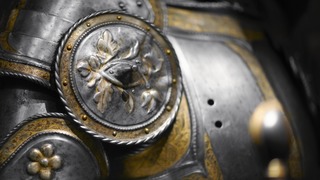
There are three related types of Neolithic earthwork that are all sometimes loosely called henges. The essential characteristic of all three is that they feature a ring-shaped bank and ditch, with the ditch inside the bank. Because the internal ditches would have served defensive purposes poorly, henges are not considered to have been defensive constructions. The three henge types are as follows, with the figure in brackets being the approximate diameter of the central flat area:
- Henge (> 20 m). The word henge refers to a particular type of earthwork of the Neolithic period, typically consisting of a roughly circular or oval-shaped bank with an internal ditch surrounding a central flat area of more than 20 m (66 ft) in diameter. There is typically little if any evidence of occupation in a henge, although they may contain ritual structures such as stone circles, timber circles and coves. Henge monument is sometimes used as a synonym for henge. Henges sometimes, but by no means always, featured stone or timber circles, and circle henge is sometimes used to describe these structures. The three largest stone circles in Britain are each in a henge. Examples of henges without significant internal monuments are the three henges of Thornborough Henges. Although having given its name to the word henge, Stonehenge is atypical in that the ditch is outside the main earthwork bank.
- Hengiform monument (5 – 20 m). Like an ordinary henge except the central flat area is between 5 and 20 m (16–66 ft) in diameter, they comprise a modest earthwork with a fairly wide outer bank. Mini henge or Dorchester henge are sometimes used as synonyms for hengiform monument. An example is the Neolithic site at Wormy Hillock Henge.
- Henge enclosure (> 300 m). A Neolithic ring earthwork with the ditch inside the bank, with the central flat area having abundant evidence of occupation and usually being more than 300 m (980 ft) in diameter. Some true henges are as large as this, but lack evidence of domestic occupation. Super henge is sometimes used as a synonym for a henge enclosure. However, sometimes Super henge is used to indicate size alone rather than use, e.g. "Marden henge ... is the least understood of the four British 'superhenges' ".

A rondel dagger or roundel dagger was a type of stiff-bladed dagger in Europe in the late Middle Ages, used by a variety of people from merchants to knights. It was worn at the waist and might be used as a utility tool, or worn into battle or a jousting tournament as a side arm.
The Ahlspiess was a thrusting spear developed and used primarily in Germany and Austria from the 15th to 16th centuries. The ahlspiess consisted of a long thin spike of square cross section measuring up to about a metre in length, mounted to a round wooden shaft and sometimes secured with a pair of langets extending from the socket. The length of the shaft ranged from 1.6 to 1.8 m., and located at the base of the spike was a rondel guard to protect the hands. Large numbers of these weapons have survived and are kept in the arsenal and museums of Vienna as well as the Metropolitan Museum of Art.

In archaeology, an enclosure is one of the most common types of archaeological site. It is any area of land separated from surrounding land by earthworks, walls or fencing. Such a simple feature is found all over the world and during almost all archaeological periods. They may be few metres across or be large enough to encompass whole cities.

The Giant's Ring is a henge monument at Ballynahatty, near Shaw's Bridge, Belfast, Northern Ireland. It was originally preserved by Viscount Dungannon. The inscribed stone tablet on the wall surrounding the site which details Viscount Dungannon's interest was carved by Belfast stonecarver Charles A Thompson about c.1919. This is confirmed by his granddaughter Ann Aston as told to her by him and was shown the tablet in situ by him.

Approximately 120–150 Neolithic earthworks enclosures are known in Central Europe. They are called Kreisgrabenanlagen in German, or alternatively as roundels. They are mostly confined to the Elbe and Danube basins, in modern-day Germany, Austria, Czech Republic, Slovakia, as well as the adjacent parts of Hungary and Poland, in a stretch of Central European land some 800 km (500 mi) across. They date to the first half of the 5th millennium BC; they are associated with the late Linear Pottery culture and its local successors, the Stroke-ornamented ware and Lengyel cultures. The best known and oldest of these Circular Enclosures is the Goseck circle, constructed c. 4900 BC.
A rondel is a verse form originating in French lyrical poetry of the 14th century. It was later used in the verse of other languages as well, such as English and Romanian. It is a variation of the rondeau consisting of two quatrains followed by a quintet or a sestet. It is not to be confused with the roundel, a similar verse form with repeating refrain.

A rondel (ˈrɒndl) is a circular piece of metal used for protection, as part of a harness of plate armour, or attached to a helmet, breastplate, couter or on a gauntlet.

The Air Force checkerboard is a national marking for the aircraft of the Polish Air Force, equivalent to roundels used in other nations' air forces. It consists of four equal squares, of which the upper left and lower right are white, and the other two – red. These are surrounded by a border of inverted (counterchanged) colors 1/5 the thickness of a single square. In 1993 the colors were reversed.
A roundel is a form of verse used in English language poetry devised by Algernon Charles Swinburne (1837–1909). It is the Anglo-Norman form corresponding to the French rondeau. It makes use of refrains, repeated according to a certain stylized pattern. A roundel consists of nine lines each having the same number of syllables, plus a refrain after the third line and after the last line. The refrain must be identical with the beginning of the first line: it may be a half-line, and rhymes with the second line. It has three stanzas and its rhyme scheme is as follows: A B A R ; B A B ; A B A R ; where R is the refrain.
Aircraft markings are symbols and annotations painted on aircraft, primarily for identification. Types of aircraft markings include:

Mosque lamps of enamelled glass, often with gilding, survive in considerable numbers from the Islamic art of the Middle Ages, especially the 13th and 14th centuries, with Cairo in Egypt and Aleppo and Damascus in Syria the most important centres of production. They are oil lamps, usually with a large round bulbous body rising to a narrower waist, above which the top section is flared. There is usually a foot so they can be placed on a surface, but they were normally used suspended by chains that went through a number of loops on the outside of the body. They were used to light mosques and other buildings in mosque complexes, in large spaces in groups hanging from a circular metal frame. The circular frames continue to be used in many mosques today, but with plain or frosted glass lamps for electric lighting.

This is a listing of the nationality markings used by military aircraft of the United States, including those of the U.S. Air Force, U.S. Navy, U.S. Marine Corps, U.S. Coast Guard, U.S. Army and their predecessors. The Civil Air Patrol is also included for the World War II period because it engaged in combat operations which its July 1946 charter has since explicitly forbidden.

The simple dolmen or primeval dolmen is an early form of dolmen or megalithic tomb that occurs especially in Northern Europe. The term was defined by archaeologist, Ernst Sprockhoff, and utilised by Ewald Schuldt in publicising his excavation of 106 megalithic sites in the north German state of Mecklenburg-Vorpommern. The simple dolmen emerged in the early days of the development of megalithic monuments of the Funnelbeaker culture (TBK) and around 3,500 BC they appeared across almost the entire region covered by the stone cult structures of Nordic megalith architecture, but not in the Netherlands, in Lower Saxony west of the River Weser nor east of the River Oder and only once in Sweden.

A rectangular dolmen, extended dolmen or enlarged dolmen is a specific type of megalith, rectangular in shape, with upright sidestones and, usually, two capstones. The term rectangular dolmen was coined by Ekkehard Aner and is used especially in the German state of Schleswig-Holstein, where dolmens with this type of ground plan primarily occur. A more precise term, however, is extended dolmen, used by Ewald Schuldt and Ernst Sprockhoff, because these types of dolmen also occur with trapezoidal ground plans.
This page is based on this
Wikipedia article Text is available under the
CC BY-SA 4.0 license; additional terms may apply.
Images, videos and audio are available under their respective licenses.
















